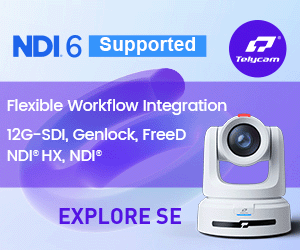HOLLYLAND Lark 150 review
The exponential growth of video supercharged a technological revolution that began in the early noughties with the advent of DSLR cameras.
The cinematic-style shallow depth of field image video quality from DSLRs was a revelation, but, back then audio was the big drawback. As demand has grown so the technology has improved and today’s one-man-band small rig set ups can capture pretty good sound into a DSLR style camera.
The Hollyland Lark 150 transmitter system is illustrative of just how far audio capture equipment for the prosumer market has come. The product is perfectly designed and engineered to meet the needs of today’s prosumer market. Firstly, while it is small and lightweight it also packs a real punch in terms of what it can do. Secondly, it’s intuitive and user-friendly - no manual required.
Perhaps the neatest feature of the set-up is the case that is used to store the two transmitters and receiver, which also doubles as a charging box. It’s not only a clever way to store the elements in one place, but it also means that if you are on a shoot, when you break for lunch you can quickly drop the transmitters and receiver into the magnetised charging slots within the box and leave them to power up. There’s a battery built into the case (it took around 2.5hrs to charge the case from empty to full in my test), which means it can be charged in advance, so power or wires aren’t required on set. A light flicks on at the front of the case to show that it is charging the items inside and a magnetic lid closes with a satisfying ‘clunk’.
There’s an empty space in the case which could be used to fit the TRS wire that connects the receiver to the camera. The set up comes with a pouch to store everything, but it would have been useful if room had been made on the charging box to fit the microphones as well.
The small is best rationale is also reflected in the transmitters which are each not much bigger than an SD card. The receiver unit is about the size of the two transmitters combined. While all the parts are made of plastic, so don’t feel as solid and durable as metal, they are very light, which is a plus for a one-man band set up. On my testing a full charge lasted just over 4 hours, so you’re not panicking that a transmitter/receiver is about to die on you.
The ability to have two transmitters send separate audio feeds to one receiver is a great feature that saves space and weight.
The transmitters and receiver automatically pair up when they are removed from the charging case. They really are ‘plug in and play’ with each featuring one button that doubles as an on/off switch and a mute function. There is the option to record audio through an onboard microphone as well as a socket to attach a lavaliere microphone. Two lavaliere microphones are included in the box as well as a couple of wind screens that come with a rubber plug that can be slotted into the headphone socket.
The receiver is an equally simple design and a full charge lasted for 7.5hours on my test. A belt clip doubles up as a foot to slot into the hot shoe on the camera, again a nice solution and it worked well.
When it comes to track and levels selection there are three options. By default the system is set up to record stereo – with the receiver recording a separate channel for each of the transmitters. Two dials on the receiver enable the volume for each of the transmitters to be controlled independently. A press and hold of the lefthand volume button switches the set up to mono – with both tracks recording to both channels. The final option is to record a track that has an additional automatic safety track that records at 6 decibels lower. In keeping with the design of the rest of the product the receiver display is simple and clear and just shows battery levels for the receiver and both transmitters, signal strength for each transmitter and the setting (ie mono, stereo or safety track).
All these neat solutions are well and good, but how does it perform and what is the quality of the audio like? Well, in my testing I found the range to be good, with the transmitter sending a signal to the receiver from the 300ft that the products claims in its specs. The sound quality is pleasantly good and would certainly be good enough for a lot of situations, from weddings to low end commercial shoots. I would say the quality doesn’t have quite the richness of professional radio mic set ups, but it’s not bad and with a bit of post-production work it can be polished up to get a very good sound.
Overall, I really like this bit of kit, and at a cost of just over £300, I think it’s really good value for something that is the equivalent to two radio mic sender/receiver packs. If I’m being really picky it would have been nice to have had a plug included, to enable me to attach the USB-C cable directly to a socket but that really is a minor thing and pales into insignificance against the cost and quality of the product.







































